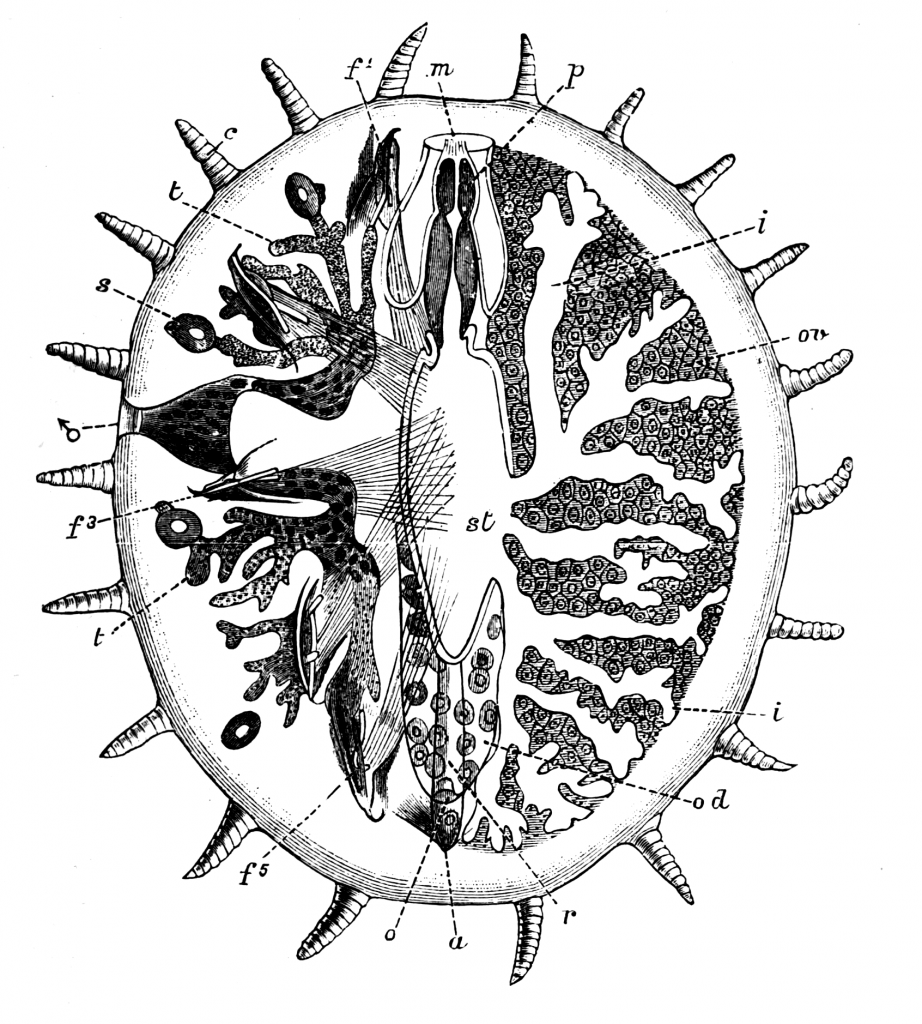
Myzostoma cirrifera. Upper layer of internal organs on the right, lower level at left. More on this guy below. Creative Commons W. Blaxland Benham (after Lang and von Graf)
As we ended last year with a slide show, so shall we begin this year with another. The Census of Marine Life has been a herculean 10-year mission to seek out new life and new civilizations (OK, maybe just one of those) in the ocean. The hundreds of scientists involved have succeeded spectacularly, though still have likely only scratched the surface.
Last fall scientists disclosed many of their results, and some of the most striking images have been collected by National Geographic into a tome called “Citizens of the Sea“, available since last fall. Cornelia Dean (science reporter and former science editor at the New York Times, who I was fortunate enough to meet in grad school (for science writing)) reviewed the book in the Science Times on Tuesday, and included a spectacular slide show that is above all what I’d like you to look at today.
But before I write more about that, my first impression of the book from flipping through it on Amazon is that it is curiously out-dated graphically. Its chunky photo layout and washed-out art seem like something you’d find in a National Geographic book from the 1980s. It pales in comparison to the stunning layouts and vivid photography of the University of Chicago Press’s “The Deep” and DK Books’ “Reef” and “Prehistoric Life”. The book also seems heavily weighted (as most are) toward metazoans, or, to put in in English, the big stuff in the ocean. As usual, microbes, protists, and larvae are missing out of proportion to their importance.
Of course, that has no bearing on the text, which I have not had time to peruse, and seems it may be more substantial than what you get in those other books since it was penned by Nancy Knowlton, a marine biologist at the Smithsonian. And judging by the nine five-star reviews at Amazon (the book received no ratings less than five), the writing is where the book shines, just as much as it is wanting in those other books.
Still, as Ms. Dean points out, the book is a bit scattershot taxonomically, making it hard for readers to understand biodiversity systematically. That omission — common to many books — is part of why I started this blog. When you can fit new organisms into general taxonomic groups in your head and relate them to other groups, it not only makes organisms easier to remember and their biology more understandable, it helps you understand the path of evolution too.
OK, back to what really matters: the critters. A few comments on the organisms in the slide show: When I was in grad school (for mycology), I studied fungal spores that, while admittedly huge for fungi, were on the order of the same length as the copepod (Ceraqtonotus steinigeri) pictured in the show — 200-300 micrometers (not my spore photo, but take a look here). That’s right: there are fungal spores as big as that copepod, which looks like it could be shrimp-sized if you didn’t have the scale bar to tell you better. Think about that.
You’ll also notice that the show features two — count ‘em, 2! — new Arctic bryozoan species. Remember the bryozoans — the moss animals? I covered them in my first guest blog at Scientific American. The photographs are of their calcareous skeletons only — the little animals you’d find poking their lophophores (crown of feeding tentacles) out of those holes are conspicuously absent, probably due to the preparation method involved in scanning electron microscopy — that is, spraying your sample with a film of gold.
Finally, I want to point out a delightful little organism new to me — the myzostomid, or parasite of crinoids, or sea lillies near the end of the show (see additional illustration at top of this post). I could write a whole book about the sea lillies and their charms (they were super-abundant in former times, and their fossils are still so. You can find little stem pieces in marine rocks all over North America, and the most stunning collections of fossilized sea-lily beds are swirling virtuoso works of Art Nouveau). But this little guy (being unceremoniously trod upon by a limelight-hogging shrimp) is apparently a representative of an entire group that has evolved just to parasitize sea lillies*. The myzostomids, while unrelated taxonomically, seem to be part flatworm (their diverticulated reproductive system resembles the dendritic digestive system of flatworms), part chiton/scale insect (their shield-like bodies). They’ve even adopted the vivid coloration of their hosts.
And here’s the kicker: they’re annelids — the group traditionally known as “segmented worms”, the most famous member being the humble earthworm. You see the segments? Me neither. Evolution: the great aimless wanderer. But oh, what beauties it stumbles into.
___________________________________________________________
*They’re active feeders on sea lillies, so I don’t know why the slide show caption says that it’s “commensal”, or a passive guest. Of course, Cornelia also says that the tubular eyes of the barreleye fish stick up above its head, when, as expertly covered by Steven Colbert two years ago, they are clearly inside its see-through head. Don’t get too mad at Cornelia, though. As a former reporter, I can say we do our best, but we’re on deadline, and sometimes we make mistakes.


{ 2 comments… read them below or add one }
Just found your blog through Emily Anthes’ (the Wonderland blog) blog roll. Love your writing. It is great to find someone who so loves taxonomy, the littlest critters, and the wonders of evolution. Looking forward to digging in to the archives and reading your new posts as well.
Thanks Sarah! Glad you’re here. : )